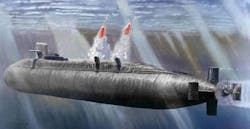Lockheed Martin to build and upgrade electronic warfare (EW) to enable submarines to detect enemy radar
Officials of the Naval Sea Systems Command in Washington are asking the Lockheed Martin Rotary and Mission Systems segment in Syracuse, N.Y., to design, upgrade, and support the AN/BLQ-10 submarine EW system, which provides automatic detection, classification, localization, and identification of potentially hostile radar and communications signals at sea.
The initial one-year contract is for $20 million, and has options for $970.1 million over the next 10 years.
The AN/BLQ-10 helps Virginia-, Los Angeles-, and Seawolf-class fast-attack submarines, Ohio-class conventional guided-missile submarines, and future Columbia-class ballistic-missile submarines detect enemy radar and communications. It is not for existing Ohio-class ballistic-missile submarines.
The order calls for Lockheed Martin to provide upgrade kits and spare parts for the AN/BLQ-10, covering advanced processor builds and technology insertion (APB/TI) cycles TI-20, TI-22, and TI-24. Efforts include work on new-construction and in-service submarines.
The AN/BLQ-10 processes signals from the submarine’s imaging mast or periscope when the boat is at periscope depth. It provides threat warning to avoid counter-detection and collision; determines the number and location of targets for subsequent prosecution; and conducts intelligence, surveillance, and reconnaissance (ISR) to support the fleet or battle group.
The program is adopting an open-architecture, incremental development process that fields hardware and software technology insertions every two years. The AN/BLQ-10 blends modular interoperable systems that adhere to open standards with published interfaces.
The system's first technology insertion in 2008 added a subsystem to intercept some low-probability-of-intercept radar signals. Fielded upgrades from the 2010 technology insertions updated commercial off-the-shelf (COTS) processors and displays, and Improved Communications Acquisition and Direction Finding (ICADF) system.
Related: Technology comes to bear on radar and sonar
For TI-20, Lockheed Martin is building an upgraded AN/BLQ-10 for Virginia- and Columbia-class submarine new construction, and in-service Virginia-class modernization.
TI-22 work will provide upgraded AN/BLQ-10 systems for in-service Los Angeles- and Seawolf-class attack submarines, as well as for Ohio-class conventional missile submarines. TI-24 work will build an upgraded AN/BLQ-10 for Virginia-class and Columbia-class new construction, as well as for in-service Virginia-class modernization.
On this order Lockheed Martin will do the work in Syracuse, N.Y.; and Manassas, Va. For more information contact Lockheed Martin Rotary and Mission Systems online at www.lockheedmartin.com, or Naval Sea Systems Command at www.navsea.navy.mil.
Ready to make a purchase? Search the Military & Aerospace Electronics Buyer's Guide for companies, new products, press releases, and videos
